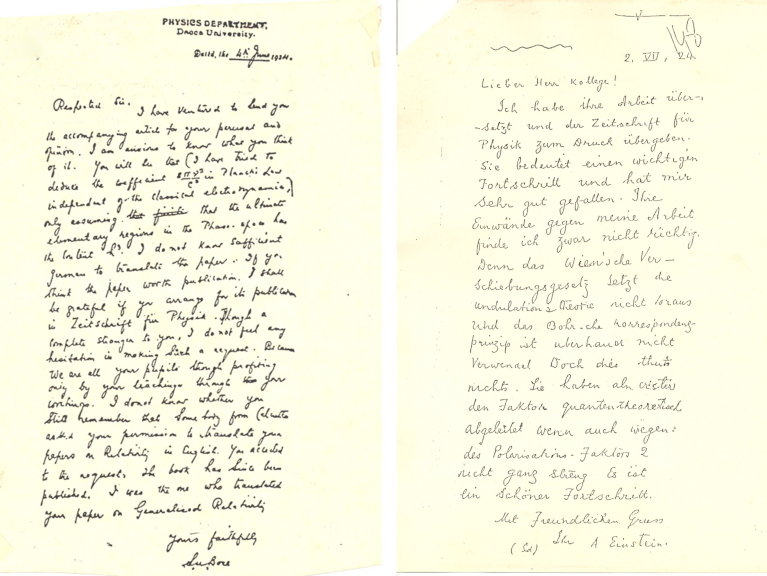This year marks the centenary of Bose statistics, physicist Satyendra Nath Bose's groundbreaking work that described elementary quantum particles, and eventually led to ‘Bose-Einstein statistics’ — a collaboration that fuels today’s quantum revolution.
In 1924, Bose proposed a new approach to understanding the behaviour of particles or photons, based on quantum theory. Bose statistics1 set off quantum mechanics and became a springboard for many physical theories and Nobel prize-winning discoveries. It also defined bosons, fundamental particles that form half the particles in nature and play by the Bose statistics rules.
Subsequent studies in quantum mechanics — the physics of subatomic particles — ushered in the first quantum revolution with technological breakthroughs such as semiconductors, MRI imaging and lasers.
History often highlights Einstein’s Theory of Relativity, the weirdness of quantum mechanics with Schroedinger’s cat, and Heisenberg’s Uncertainty Principle, says Alexander Blum at Max Planck Institute for History of Science, Berlin, Germany. “But there are several deep insights that are philosophically equally interesting – like the explanation of the identity of atomic particles.”
India launched its National Quantum Mission in 2023, in step with what experts call the second quantum revolution. “We are trying to tweak quantum mechanics to make it more precise for real-world applications such as sensing, timekeeping, and communications,” said Manik Banik, a convener of the Bose Statistics centenary celebrations at S. N. Bose National Centre for Basic Sciences in Kolkata.
Scientists are now focused on manipulating individual quantum objects such as atoms, photons and electrons. A case in point is quantum entanglement — connecting particles (or qubits) invisibly across space and time to transmit information –one of the four technologies highlighted in India’s national initiative.
The others are quantum computing, quantum sensing and metrology and quantum materials and devices, all of which show “the gap between fundamental science and technological intervention is now closing,” explains Ravindra Pratap Singh, who leads the Quantum Science and Technology programme at the Physical Research Laboratory, in Ahmedabad.
The World Economic Forum reports over $40 billion in public investments globally in quantum efforts and projects a $106 billion quantum technology market by 2040. “This roadmap to transition to the quantum economy begins with technologies, many of which are rooted in Bose’s work,” says Banik.
An unsolicited letter from Bose to Einstein
On 4 June 1924, Bose sent a short paper to physicist Albert Einstein, challenging the derivation of an existing physical law on light-matter interaction. Bose then taught physics at the University of Dacca in British India (now University of Dhaka in Bangladesh). He disagreed with previous derivations of Planck’s Law, including those by Einstein, which used traditional statistics to describe the behaviour of particles like photons.
In his letter, describing a new approach to analysing behaviour of photons based on quantum theory, Bose asked Einstein to evaluate and publish the paper. Einstein, a Nobel laureate by then, recognized its significance and published it in a German physics journal on 2 July 1924, with a footnote endorsing his work.
The paper contained the ideas of indistinguishability and an additional degree of freedom of photons, which gave rise to Bose statistics, says Bose’s former student Partha Ghose. Ghose adds that his paper was the last of the four landmark publications that led to new quantum mechanics. The others were those of Max Planck in 1900, Einstein in 1905, and Niels Bohr in 1913. From 1925 onwards, everything on quantum theory was incorporated into a consistent theory known as quantum mechanics, says Ghose.
“What Einstein basically did was to write that it was not as simple as he (Bose) made it look like and there's a very big idea involved here, which is a new kind of statistics (quantum statistics),” says Blum. It was a means for statistical counting of very large numbers of light particles (photons), but it quickly became a feature of single particles, which then get the name boson, he says. The other type of particles are fermions, which follow the Fermi-Dirac statistics.
Bose-Einstein statistics in real-world scenarios
Interactions between Bose and Einstein resulted in a new statistical tool, the Bose-Einstein statistics, introduced for photons in 1924 by Bose and generalized to atoms by Einstein in 1924–25. It also led to the prediction of a new state of matter, the Bose-Einstein condensate (BEC), a supercooled collection of bosons, all at the same energy, in a quantum wave.
For context, even extremely cold regions in intergalactic spaces are millions of times too warm for Bose condensation.
The BEC was discovered experimentally 70 years later by Eric A. Cornell, Wolfgang Ketterle and Carl Wieman who shared the 2001 Nobel prize in Physics for proving the phenomenon. BECs, which help understand more complex situations in solids such as superconductivity, are used to create high-precision atom lasers, atomic clocks and sensors.
Physicist Parongama Sen at the University of Calcutta says there’s a renewed interest in BEC because “you can see the signatures of BEC in experiments."
“Superfluidity may co-occur with BEC,” she says. In recent years, scientists have shown a type of Bose-Einstein condensation in real space such as in cluster aggregation and fragmentation, traffic jams and granular flow, and granular clustering. Virtual spaces such as socio-economic systems also carry signatures of BEC which can be studied using the tools of statistical physics. Examples include a wealth condensation phenomenon in macroeconomics where a single individual or a company owns a finite fraction of the total wealth, says Sen.
Ghose notes that these scientific pursuits indicate that researchers are turning to fundamental ideas such as Bose statistics to see if they can explain otherwise unexplainable phenomena. But the question of why there is a division of basic structure of nature into fermions and bosons is still wide open.

